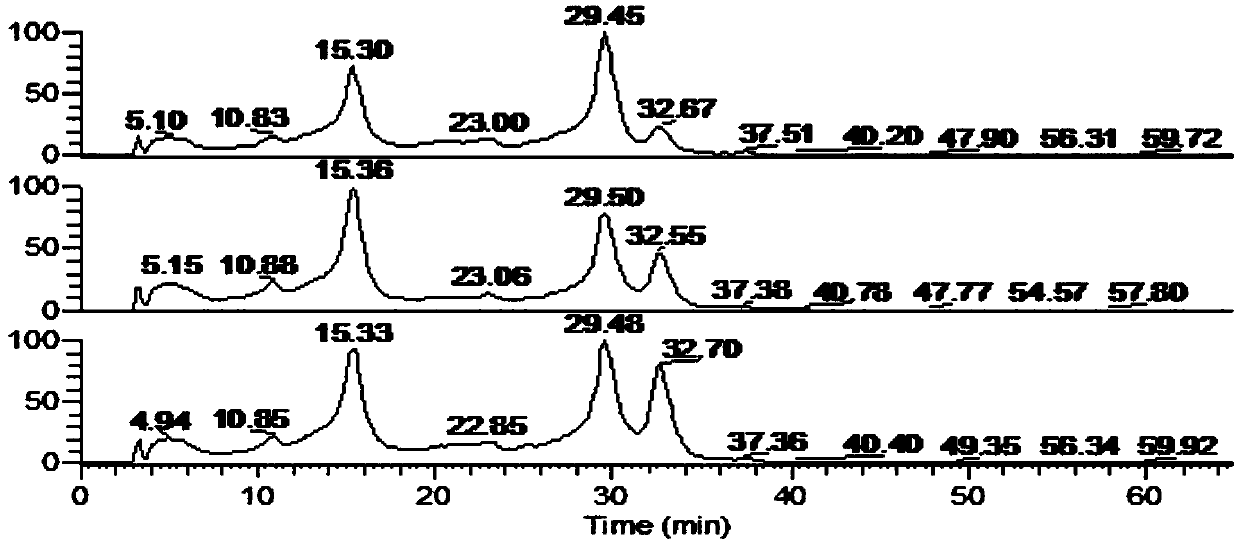Fermentation method for bacillus subtilis to produce chlorogenic acid
A chlorogenic acid and bacterial fermentation technology, which is applied in microorganism-based methods, fermentation, biochemical equipment and methods, etc., can solve the problems of underutilization of resources, etc., and achieve easy access, simple extraction methods, and improved ability. Effect
- Summary
- Abstract
- Description
- Claims
- Application Information
AI Technical Summary
Problems solved by technology
Method used
Image
Examples
Embodiment 1
[0035] Strain activation and inoculation: activate strain RP5, use PDB medium, 37°C, 200revmin -1, shake the flask for 20h. Inoculation: Take 200 grams of fresh sweet potato leaves that have been grown for 4-5 months, cut them into pieces to make a homogenate, boil for 10 minutes, then filter with a single layer of gauze, add distilled water to 1L, and obtain a crude sweet potato leaf extract. Then add (g): sucrose (40), soybean peptone (10), ammonium chloride (5), copper sulfate (0.04). Autoclaved at 115°C for 20min. Inoculate (2%) the activated bacterium liquid to the 250ml Erlenmeyer flask that 100ml culture medium is housed, and at 37 ℃, 200revmin -1 Rotating culture at 100°C for 28h.
Embodiment 2
[0037] Extraction of chlorogenic acid: after 28 hours of incubation on a shaking table. Centrifuge (5000g, 20min), take the supernatant, adjust the pH of the fermentation broth to 4, to maintain the stability of chlorogenic acid, add an equal volume of 70% ethanol and ultrasonically treat (40°C, 10min) to speed up the conversion of liquid to mass Extraction efficiency, then rest overnight. Concentrate in vacuum with a rotary evaporator to 20ml, adjust the pH to 2-3 with concentrated hydrochloric acid, then add an equal volume of ethyl acetate to extract three times, each time for 1h, take the ethyl acetate layer and concentrate in vacuum to almost dryness, add 5ml of chromatographic methanol to completely Dissolve, filter with an organic filter, remove the insoluble matter in the sample and prepare the sample solution to be tested
Embodiment 3
[0039] HPLC quantitative analysis of chlorogenic acid content in the sample solution: HPLC detection conditions, the chromatographic column is WatersC18column (75mm×4.6mm, 3.5μm), the mobile phase is acetonitrile: 0.5% phosphoric acid water (13:87, v / v), and the flow rate is 1.0 mlmin -1 , the column temperature is 35° C., the injection volume is 10 μl, and the detection wavelength is 325.2 nm. By measuring the accumulation yield of chlorogenic acid can reach 54.60mgl -1 , the ability of RP5 to ferment and produce chlorogenic acid increased by 37.75mgl -1 , is the initial fermentation of RP5 (1.58mgl -1 ) of 23.90 times and compared to the chlorogenic acid content (18.32mgl -1 ) 2.06 times. HPLC retention time and absorption wavelength see figure 1 .
PUM
 Login to view more
Login to view more Abstract
Description
Claims
Application Information
 Login to view more
Login to view more - R&D Engineer
- R&D Manager
- IP Professional
- Industry Leading Data Capabilities
- Powerful AI technology
- Patent DNA Extraction
Browse by: Latest US Patents, China's latest patents, Technical Efficacy Thesaurus, Application Domain, Technology Topic.
© 2024 PatSnap. All rights reserved.Legal|Privacy policy|Modern Slavery Act Transparency Statement|Sitemap



